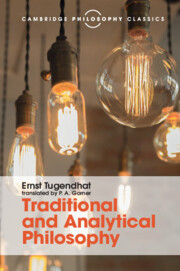Book contents
- Frontmatter
- Dedication
- Contents
- Preface
- Preface
- Translator's preface
- Part I Introduction: confrontation of analytical philosophy with traditional conceptions of philosophy
- Part II A first step: analysis of the predicative sentence
- 8 Preliminary reflections on method and preview of the course of the investigation
- 9 Husserl's theory of meaning
- 10 Collapse of the traditional theory of meaning
- 11 Predicates: the first step in the development of an analytical conception of the meaning of sentences. The dispute between nominalists and conceptualists
- 12 The basic principle of analytical philosophy. The dispute continued. Predicates and quasi-predicates
- 13 The meaning of an expression and the circumstances of its use. Dispute with a behaviouristic conception
- 14 The employment-rule of an assertoric sentence. Argument with Grice and Searle
- 15 Positive account of the employment-rule of assertoric sentences in terms of the truth-relation
- 16 Supplements
- 17 ‘And’ and ‘or’
- 18 General sentences. Resumption of the problem of predicates
- 19 The mode of employment of predicates. Transition to singular terms
- 20 What is it for a sign to stand for an object? The traditional account
- 21 The function of singular terms
- 22 Russell and Strawson
- 23 What is ‘identification’?
- 24 Specification and identification. Specification and truth
- 25 Spatio-temporal identification and the constitution of the object-relation
- 26 Supplements
- 27 Results
- 28 The next steps
- Bibliography
- Index of names
- Index of subjects
17 - ‘And’ and ‘or’
from Part II - A first step: analysis of the predicative sentence
Published online by Cambridge University Press: 05 August 2016
- Frontmatter
- Dedication
- Contents
- Preface
- Preface
- Translator's preface
- Part I Introduction: confrontation of analytical philosophy with traditional conceptions of philosophy
- Part II A first step: analysis of the predicative sentence
- 8 Preliminary reflections on method and preview of the course of the investigation
- 9 Husserl's theory of meaning
- 10 Collapse of the traditional theory of meaning
- 11 Predicates: the first step in the development of an analytical conception of the meaning of sentences. The dispute between nominalists and conceptualists
- 12 The basic principle of analytical philosophy. The dispute continued. Predicates and quasi-predicates
- 13 The meaning of an expression and the circumstances of its use. Dispute with a behaviouristic conception
- 14 The employment-rule of an assertoric sentence. Argument with Grice and Searle
- 15 Positive account of the employment-rule of assertoric sentences in terms of the truth-relation
- 16 Supplements
- 17 ‘And’ and ‘or’
- 18 General sentences. Resumption of the problem of predicates
- 19 The mode of employment of predicates. Transition to singular terms
- 20 What is it for a sign to stand for an object? The traditional account
- 21 The function of singular terms
- 22 Russell and Strawson
- 23 What is ‘identification’?
- 24 Specification and identification. Specification and truth
- 25 Spatio-temporal identification and the constitution of the object-relation
- 26 Supplements
- 27 Results
- 28 The next steps
- Bibliography
- Index of names
- Index of subjects
Summary
In the lecture before last we arrived at a first, preliminary result in the enquiry into the meaning of assertoric sentences. In the last lecture I related this result to other possible conceptions and then supplemented it in an essential respect. I had started from the assumption that to understand a linguistic expression is to understand its employment-rule. It became clear that the understanding of its employment-rule consists not in knowing in what circumstances it is used, but rather in knowing what its function is; and that this function consists in asserting something. So far we have only been able to determine in a general way what this means. To assert something is to perform the opening-move in a verification-game. Such a game has the following defining features. There are two mutually negating opening-positions. The rules of the game are verification-rules. The outcome of the game is characterized thus: on the basis of following the verification-rule the one assertion turns out to be true, the other false, or one assertion must be withdrawn in favour of the other. It followed from this general characterization of the employment-rules of assertoric sentences that the explanation of the use of such a sentence must consist in the explanation of its verification-rule. It was this question that remained open and to which we must now turn. It had to remain open, because in general nothing can be said about the verification-rules of assertoric sentences. They must be shown separately for the different sentence-forms or, better: different sentence-forms are distinguished precisely by having different sorts of verification-rule. (Should that prove to be correct then we would have a basis for rendering precise the concept of semantic form that has hitherto remained vague.)
The account given so far is thus not only abstract; it is also incomplete so long as it has not been shown how the verification-rules of specific sentence-forms can be explained. Only by doing this will we be able to see how far this conception really provides a basis for the explanation of the meaning of individual sentences and sentence-parts.
Now we saw at the end of the last lecture that the view that the employment-rule (meaning) of a sentence is its verification-rule must be corrected.
- Type
- Chapter
- Information
- Traditional and Analytical PhilosophyLectures on the Philosophy of Language, pp. 236 - 252Publisher: Cambridge University PressPrint publication year: 2016



